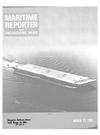
Page 24: of Maritime Reporter Magazine (March 15, 1981)
Read this page in Pdf, Flash or Html5 edition of March 15, 1981 Maritime Reporter Magazine
Sail-Equipped
Motorship (continued from page 24) is constant, ship speed is not con- stant as it depends on wind uti- lization. However, if the average ship speed throughout the entire voyage is the same as in (1), it becomes possible to use a smaller main engine than is used on con- ventional ships.
After comparing the two pos- sibilities and considering the im- plications of propulsion control concerning ship schedules, it can be seen that possibly (1), in which the ship speed remains con- stant, is far more practical.
In the case of the speed being kept constant, the relationship between the propulsive power of the sails and main engine output is as shown in Figure 2. The main engine is controlled in such a way that total output will be constant as much as possible.
In this system, when a fixed- pitch propeller is used, the num- ber of revolutions is controlled. If a variable-pitch propeller is used, the blade angle and number of revolutions are controlled result- ing in an engine load that achieves maximum fuel economy while keeping constant speed.
DURAMAX Naval Brass Sleeve and
Flanged Water-Lubricated Bearings are available in a full range of shaft sizes. Stuffing Boxes, including the popular inflatable rubber ring style, are available for water, grease, or combination water/grease service.
Write or Call for Data on Bearings, Stuffing Boxes and Keel Coolers.
DURAMAX MARINE division of The Johnson Rubber Company • T M Reg PRINTED IN USA
Middleheld. Ohio 44062 USA Area Code: 216-632-1611
TWX 810-427-2960 Telex 98-0416 Cable DURAMAX
Dependable Products For Ships Throughout The World
Ship Speed
Constant / Accelerative
NSO Total Output
D Q. "5 o A \ 0
Wind Speed 26 Write 227 on Reader Service Card
Figure 2 — Relationship between propul- sion power of sails and main engine with ship's speed being kept constant.
Conclusions
Through these studies and tests, main results were obtained as follows: 1. The sail-equipped motorship in which sails are used as aux- iliary (not as main) source of propulsion seems to be most fea- sible at the present stage. 2. Laminar flow type rigid sails which were mechanized fully were found to be one of the optimums for practical sail equipment. 3. Considering the increase of the fuel oil price in the future, sail-equipped motorships seem to be economically feasible at this time, by the effect of the cost- down of sailing equipment.
Ocean transportation is in a state of emergency due to recent rapid increases in the price of fuel for ships and to the growing uncertainty of fuel supply, both of which have made it impera- tive to take measures for the con- servation of fuel. Under such con- ditions, the re-emergence of wind force as a natural source of en- ergy for the propulsion of ships through modern techniques has become of great significance.
Even during the period of two years while this research and de- velopment was being conducted, the petroleum situation has un- dergone drastic changes. These conditions indicate that the time is fast approaching when sail- equipped motorships will become feasible on a commercial basis.
As a result of feasibility stud- ies made using a 10,000 to 35,000- dwt bulk carrier, the first stage of the development process, it was established that this type of ship can be operated profitably.
However, when the actual equip- ping of the ship was considered, there were and still are many problems to be solved regarding maneuverability which must be studied in more detail; maneu- verability in docking, mooring and when in harbor movement; the crew needed for this type of ship and their mastery of the operational techniques; the selec- tion of the most suitable routes for specific voyages, etc. Solving these problems has thus become the task that will be undertaken (continued on page 28)
Write 354 on Reader Service Card
Maritime Reporter/Engineering News as well as an ocean engineering research vessel. The
Jekyll Isle holds American Bureau of Shipping Classi- fication for Unrestricted Ocean Service and carries
U.S. Coast Guard Certification under Subchapter I for Unrestricted Ocean Service. The 76-foot, twin screw vessel features fuel-saving Kort Nozzles in her twin propulsion system, which deliver a combined shaft rating of 1200 horsepower. Johnson- Duramax®
Flanged Bearings, Sleeve Bearings and Stuffing
Boxes are installed on the vessel's 4-1/2 " propulsion and rudder shafts. The design and outfitting gives the Jekyll Isle its world-wide operation capabilities.
She's versatile and exceptionally well-built, is how the owners, Jekyll Towing and Marine Service Corpo- ration, Jekyll Island, Georgia, describe this newest in a series of tugs from Gladding-Hearn.
For performance reliability, you, too, can depend on
Johnson-Duramax® Marine Products.
The Jekyll Isle is a unique vessel when it comes to per- formance. It reflects the innovative design concepts of
Gladding-Hearn Shipbuilding Corporation of Somerset,
Mass., who has produced a combination sea-going tug,

 23
23

 25
25
